Published 3 SEP 2024
Ugo Rondinone
the alphabet of my mothers and fathers
Opening – 13 SEP 2024
13 SEP until 19 OCT 2024
We are nothing without food. The spread of farming led to food surpluses, which spared some of us the daily chore of hunting and gathering. Trades and professions emerged as agriculture grew more efficient with the use of tools, further shrinking the number of people tasked with food production. Farmers, cooks and their tools made us sedentary, enabled cities and empires to arise, encouraged the standardisation of alphabets and numerical systems, and facilitated the proliferation of knowledge and art. Today, in the industrialised world, the workers needed to supply us with food is a tiny, single-digit percentage of the population while farming’s old tools have all but vanished.
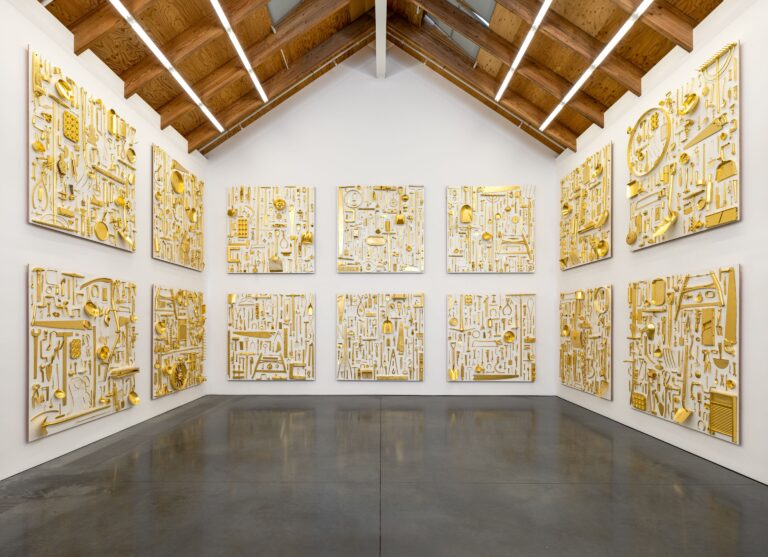
Ugo Rondinone, the alphabet of my mothers and fathers, 2022,
gilded farmers’ tools.
Exhibition view: Artists Choose Parrish, Part 1, Parrish Art Museum (2023).
Photo © David Regen
Ugo Rondinone’s the alphabet of my mothers and fathers, 2022, consists of twenty-six sets of gilded farm tools, one per letter of the alphabet. Hand-made by their users for countless generations, these were the implements of traditional farming and food preparation. By applying them with gold leaf and mounting them on white squares, Rondinone transforms the tools into regal hieroglyphs of ingenuity and skill.
A son of Southern Italian farmers who emigrated to Central Switzerland, Rondinone’s ancestors made and used such tools for unknown centuries. Cultivation, after all, has been practiced for thousands of years in Italy. Indeed, it was the imperial Romans of central Italy who introduced advanced agricultural techniques—irrigation, crop rotation, the use of specialised tools—throughout Europe and the Mediterranean.
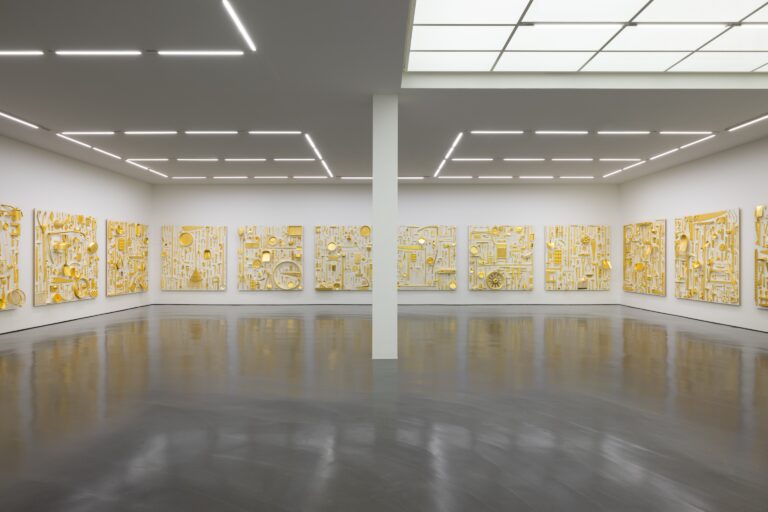
Exhibition view: Ugo Rondinone, the alphabet of my mothers and fathers, Esther Schipper, Berlin, 2024
Courtesy the artist and Esther Schipper, Berlin/Paris/Seoul
Photo © Andrea Rossetti
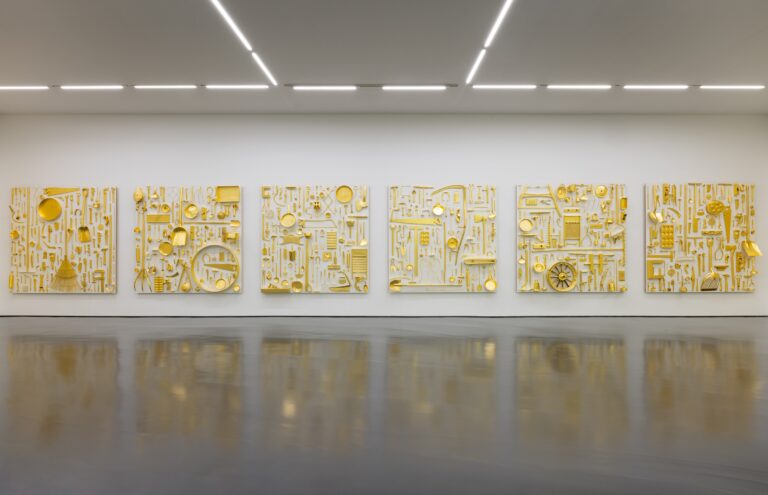
Exhibition view: Ugo Rondinone, the alphabet of my mothers and fathers, Esther Schipper, Berlin, 2024
Courtesy the artist and Esther Schipper, Berlin/Paris/Seoul
Photo © Andrea Rossetti
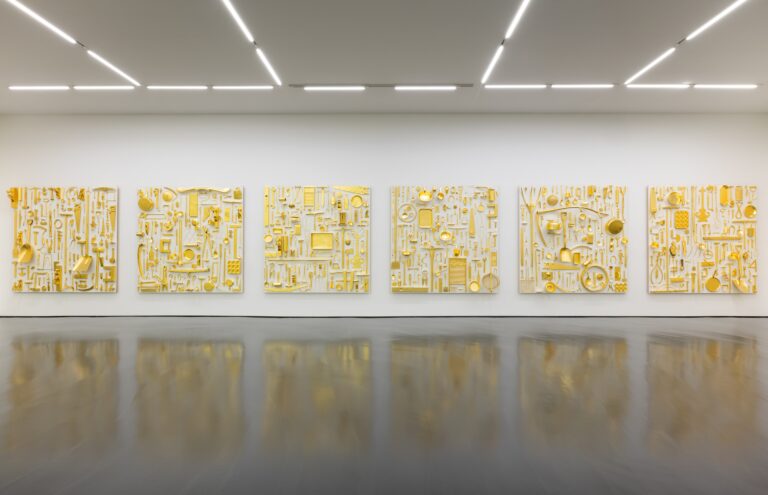
Exhibition view: Ugo Rondinone, the alphabet of my mothers and fathers, Esther Schipper, Berlin, 2024
Courtesy the artist and Esther Schipper, Berlin/Paris/Seoul
Photo © Andrea Rossetti
With industrialisation came the decline of traditional farming and a simultaneous decline in the use of its tools. This cost them a good measure of their symbolic charge. Along with the knowledge of how it is used are lost the allusive implications of a tool. In response to the strong current of history that uprooted his parents, Rondinone’s alphabet archives traditional farm implements while history lets him turn them into idols.
Thanks to its untarnishable exchange value, gold’s semiotic charisma is deep and widespread. A marker of holiness and hierarchy, it was used for millennia as the exclusive ornament of gods and kings. Even today, in both the East and the West, gold’s warm shine confers instant status on what it adorns. The communist ‘hammer and sickle’ is a rare earlier instance of gilded tools. Typically depicted in gold, the symbol burnishes the triumph, optimism, and solidarity of farm and factory workers. But contemporary technology magnifies agriculture and industry’s fading reliance on labour, while it hastens the obsolescence of their symbolically potent tools.
Rondinone’s gilding has its own purpose. Each item in his golden collection is “the thing itself and not ideas about the thing,” as poet Wallace Stevens might have said. The disappearance of the tools is arrested by using gold to immortalise “the thing itself,” and not merely its cipher. When he gilds the implements of our forebears, the artist ennobles their skill and sacralises their toil, evident in the marks of wear that he dignifies with gold. Rather than ideological, the gesture is filial.
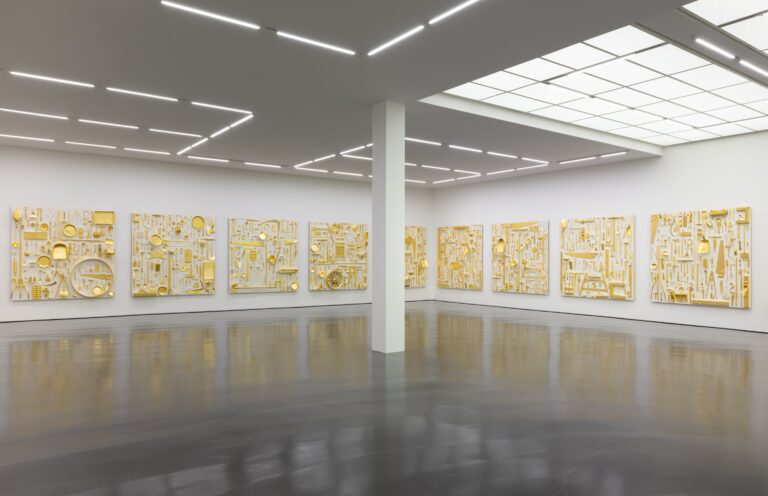
Exhibition view: Ugo Rondinone, the alphabet of my mothers and fathers, Esther Schipper, Berlin, 2024
Courtesy the artist and Esther Schipper, Berlin/Paris/Seoul
Photo © Andrea Rossetti
Ugo Rondinone is a quintessential contemporary artist. He is known for producing often staggeringly beautiful objects and experiences, but these cannot be anticipated or even recalled within the formal progression of a traditional, medium-centred practice. His is a conceptual approach with a strong inclination toward the poetical. Despite what may seem like a pragmatic attitude toward the making of art—bespoke responses to specific situations—there is a coherence to the artist’s larger practice, a coordinating intelligence.
Through his diverse and enigmatic production, Rondinone has crafted a singular artistic personality, a meta-creation that holds everything together. This stealth coherence can be glimpsed in his curatorial practice, such as in the thematic unity of his self-curated survey now on at the Kunstmuseum in Lucerne. Tightly programmatic, the exhibition gathers works from different periods to explore the nested themes of nature, representation and contemplation, revealing them like metallurgic veins in the matrix of his corpus. With his new exhibition at Esther Schipper in Berlin, Rondinone’s matrix yields gold from a vein pledged to commemoration.
A consummate inventor, Rondinone’s career consists of a succession of unexpected forms. Each conjures an array of interconnected meanings that qualify reality for the sake of enchantment. This is what we have always expected from the arts, the primary source of magic for our ancestors and for us.
— Marc Mayer
Ugo Rondinone was born in 1964 in Brunnen, Switzerland. He studied at the Hochschule für Angewandte Kunst, Vienna. The artist currently lives and works in New York.
Rondinone is recognized as one of the major voices of his generation, an artist who composes searing meditations on nature and the human condition while establishing an organic formal vocabulary that fuses a variety of sculptural and painterly traditions. The breadth and generosity of his vision of human nature have resulted in a wide range of two-dimensional and three-dimensional objects, installations, videos, and performances. His hybridized forms, which borrow from ancient and modern cultural sources alike, exude pathos and humor, going straight to the heart of the most pressing issues of our time, where modernist achievement and archaic expression intersect.
The selected recent solo exhibitions include: Cry Me a River, Kunstmuseum Luzern (2024); burn to shine, Museum SAN, Wonju (2024); sunrise. east, Städel Museum, Frankfurt (2023); burn shine fly, Scuola Grande di San Giovanni Evangelista, Venice (2022); vocabulary of solitude, Museo Rufino Tamayo, Mexico City (2022), and LIFE TIME, Schirn Kunsthalle, Frankfurt am Main (2022).
Rondinone’s work is held in the following collections: The Bass Museum of Art, Miami Beach; Centre Pompidou, Paris; Galleria Nazionale d’Arte Moderna e Contemporanea, Rome; Migros Museum, Museum für Gegenwartskunst, Zurich; Musée d’Art Contemporain, Strasbourg; National Gallery of Canada, Ottawa; New Museum, New York; The Art Gallery of New South Wales, Sydney; The Museum of Modern Art, New York, among others.
For press inquiries please contact David Ulrichs. Tel: +49 (0) 176 50 33 01 35 or david@davidulrichs.com
Hyunsun Jeon
When you understand my secret, it becomes a ghost
Opening – 13 SEP 2024
13 SEP until 19 OCT 2024
Esther Schipper is delighted to announce When you understand my secret, it becomes a ghost, Hyunsun Jeon’s first solo presentation with the gallery. On view will be 10 new paintings by Jeon whose representation was announced in February of this year.
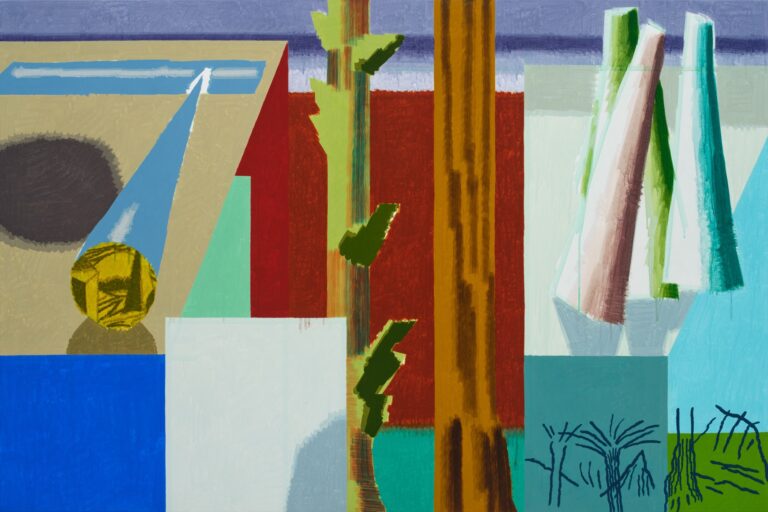
Hyunsun Jeon
Meet me in the Middle, 2024
Watercolor on canvas
100 x 150 cm
Courtesy of the artist and Esther Schipper, Berlin/Paris/Seoul
Photo © the artist
Hyunsun Jeon has developed a distinct iconography that combines figurative elements, such as trees, fruits, and objects from everyday life, with abstract forms, color planes and, increasingly since 2014, sets of classic geometric shapes. Jeon’s forms are engaged in a constant shift between dimensions and associations—a cone, for example, may occur as a triangle, rendered with color gradients to suggest depth, or in the form of volcanoes, mountains or hats. Jeon’s project has an all-encompassing, even world-building quality: quoting different styles as motifs, a work might simultaneously include painterly passages, pointillist sections or simulated brushstrokes, and motifs that have the linear quality of digital renderings or pixelation.
Installed in a loose grouping across three walls, Jeon’s constellation makes the paintings appear to shift across the space. Echoing the overlapping and superimposition of motifs in the paintings themselves, the empty sections between the works is activated and becomes present as a kind of virtual space, an effect akin to windows on a computer screen or the layering of trompe l’oeil still lifes found on traditional folding screens found throughout East Asia.
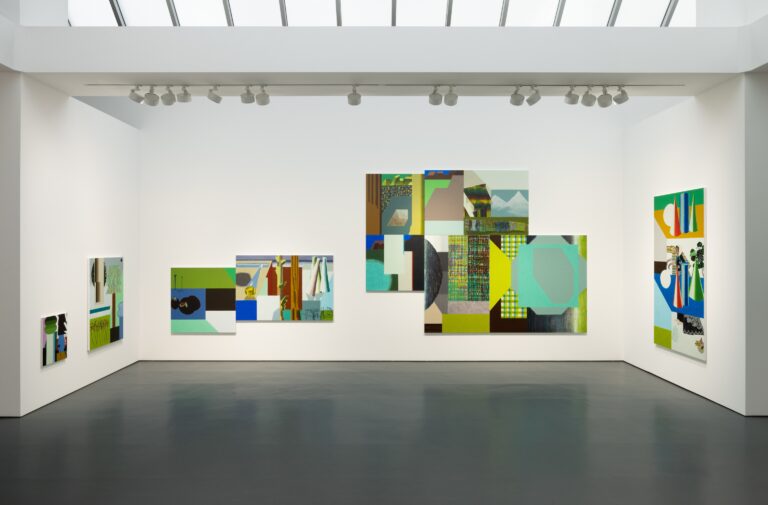
Exhibition view: Hyunsun Jeon, When you understand my secret, it becomes a ghost, Esther Schipper, Berlin, 2024
Courtesy the artist and Esther Schipper, Berlin/Paris/Seoul
Photo © Andrea Rossetti
Working in a medium that has traditionally thrived on creating the illusion of three-dimensional space on a two-dimensional surface, Jeon’s work celebrates flatness. Her preferred medium, watercolor, achieves saturation and shallowness, maintaining a relatively thin layer of paint. Sometimes pierced by holes that open up views “into” the painting or superimposed fragments, Jeon finds ways to continuously remind the viewer of the planarity of the canvas, of looking at a flat surface, and of the actual thinness of the paint that supplies the illusion of depth.
Initially drawn to the mechanics of storytelling in folktales, mythology and religion, Jeon has sought a narration specific to the practice of painting. Inspired by the scenery surrounding the religious figures in altarpieces, Jeon forges a world in which the main character—the saints and sinners—are omitted. Instead, shapes, strokes and colors, caught in the constant maelstrom of becoming, occupy it. Yet, while her art historical references to medieval altarpieces remain visible in the compositional structure, her aesthetic is grounded in the now. Jeon knowingly incorporates aspects of the digital world, particularly her generation’s familiarity with and visual socialization through early video games. To Jeon, her work is a translation into analog form of characteristics she associates with the digital—among them being clear, sharp, smooth, sleek, or superficial.
Her seriousness about what it means to be looking at something, explains Jeon’s affinity for the work of Paul Cézanne. The French painter’s comment to his younger friend Emile Bernard “to treat nature by means of the cylinder, the sphere, [and] the cone” resonated deeply with Jeon and to this day determines her artistic vision. Jeon’s paintings do not tell stories or depict situations but in making us question every shape, plane, and motif, they communicate the uncertainness of our existence.
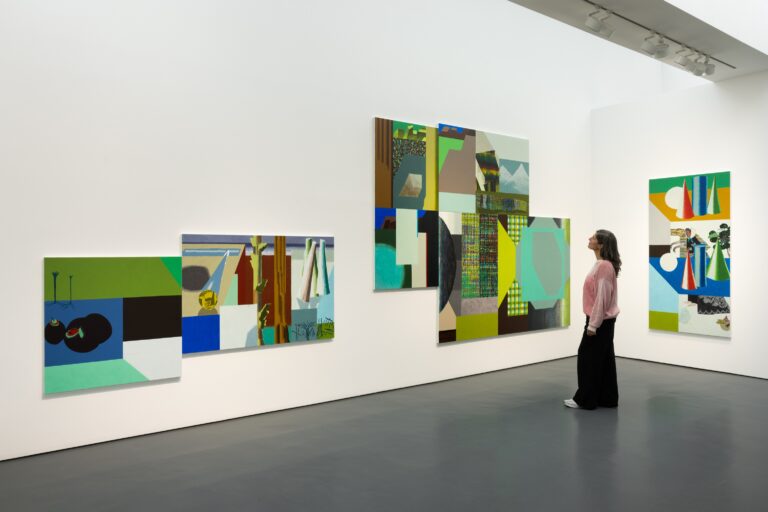
Exhibition view: Hyunsun Jeon, When you understand my secret, it becomes a ghost, Esther Schipper, Berlin, 2024
Courtesy the artist and Esther Schipper, Berlin/Paris/Seoul
Photo © Andrea Rossetti
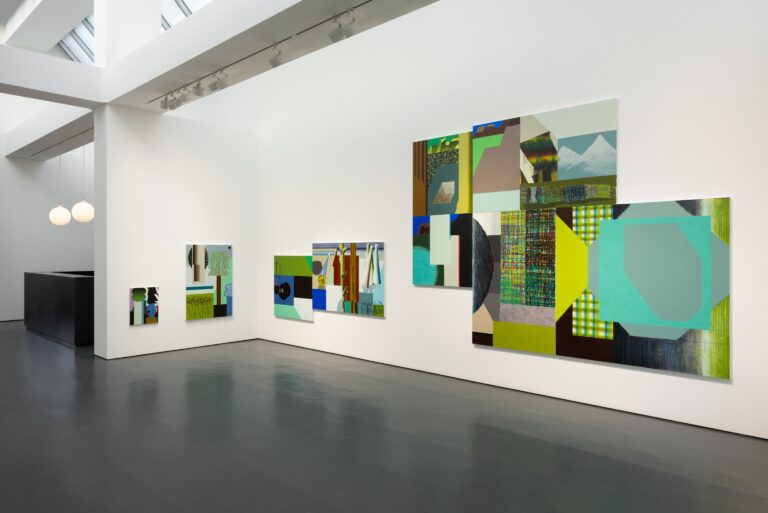
Exhibition view: Hyunsun Jeon, When you understand my secret, it becomes a ghost, Esther Schipper, Berlin, 2024
Courtesy the artist and Esther Schipper, Berlin/Paris/Seoul
Photo © Andrea Rossetti
Hyunsun Jeon was born in 1989 in Seoul. She received her BFA and MFA in painting from Ewha Womans University in 2014 and 2018. The artist lives and works in Seoul.
The artist has been awarded and selected for the 20th Song Eun Art Award, Song Eun Art and Cultural Foundation (2020), Chong Kun Dang Fine Arts Prize (2017), ARKO Artist Curator Workshop (2015), 37th JoongAng Fine Art Prize, JoongAng Ilbo (2015), 99°C Promising Art Support Program, Seoul Foundation for Arts and Culture (2014), Sangsangmadang Membership Card Artwork Proposal: Art in Your Pocket, KT&G (2013), and Seoul Digital University Art Prize (2013).
The artist’s work is held in collections including: National Museum of Modern and Contemporary Art, Seoul; Seoul Museum of Art, Seoul; Gyeonggi Museum of Modern Art, Ansan; Suwon Ipark Museum of Art, Suwon.
